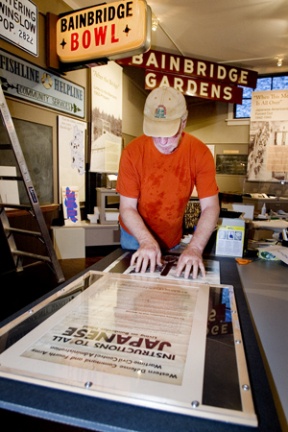The museum unveils new exhibits and a restored schoolhouse Sunday.
The dust of ages has had no time to settle.
First there was the big move. Then came a grant for building restoration, followed in turn by funds for new exhibits.
Then came the work – lots of it. Any dust lingering in the Bainbridge Island Historical Museum this week is a residual of construction as much as time.
“I never thought I’d be involved in a project this size in a museum this size,” said Lorraine Scott, curator, reflecting on the top-to-bottom makeover at the island’s repository of all things heirloom. “It’s really kind of unusual for a museum this small.”
The museum begins a new chapter Sunday with the unveiling of “A Voyage Through Bainbridge History,” a newly vintage look and more contemporary ways of carrying forward the community’s sacred lore.
Don’t ask about “permanent” exhibits; Scott eschews that term in favor of “long term,” and the displays are designed so stories and artifacts can be rotated through, keeping the museum fresh for newcomers and locals alike.
Multi-tiered cases boast many artifacts hitherto tucked way in the museum vault, where others wait their turn. Even the expansive photo-and-story panels on the walls can be updated with new text, to put a fresh spin on familiar tales.
“The curse of the permanent exhibit is, it’s great for visitors to the island, but if you live here, why would you want to come back?” Scott said.
Sunday is a defining moment for a project that began in 1999, when the BIHS board negotiated with the city to move its 1908 schoolhouse museum to Winslow from Strawberry Hill.
The building was trucked over in 2004. Besides the more central locale – within reach of walk-on ferry tourists, a constituency unserved when the museum sat a mile outside of town – the new location also afforded more space and a climate-controlled basement for collections storage.
Within a few months, the board had secured grants to restore the schoolhouse interior to its historic look and feel, and later to rework timeworn displays. Some $2000,000 later, the museum promises a new and much more interactive experience.
Typical is the exhibit “Ponderous Machinery,” which chronicles island mills from 1854-1922. Artifacts range from the great saws that tamed Bainbridge forests to tiny tokens issued to mill workers as payment for a day’s work – redeemable for goods and sundries at the Port Blakely company store.
Sound is integral to the exhibits. A display on Native American history carries a soundtrack of seagulls and water lapping at the island’s then-undeveloped shorelines; a spinning mill saw buzzes over the Port Blakely exhibit, conveying a tangible sense of the industry that came with European settlement.
Such ambient sounds are activated as visitors move to each area, while a dedicated listening station allows visitors to hear snippets of oral histories – Bainbridge lore in the words and voices of those who lived it.
The new technology also allows Scott to showcase the museum’s hearty collection of some 5,000 photographs.
Precious wall space means that only a tiny fraction of that collection could ever be displayed physically, but digital viewing stations now let the visitor scroll through a series of images that the museum staff can add to or change with ease.
“These are sort of fancy and fun, but they were always out of our reach in the past,” Scott said of the technological touches.
The displays themselves have been reorganized, and cover ground unexplored by the museum previously. One area chronicles the changing political imperatives and social outlets of Bainbridge “After the Bridge.”
The display begins with the ceremonial spade turned by Washington Gov. Arthur B. Langlie as construction began at Agate Passage in 1949, and ends with a “Save Gazzam Lake” T-shirt. Overhead, fond memories may be provoked by the kitschily glowing sign of Bainbridge Bowl, the once-popular lanes that came and went on Madison Avenue.
“People who come to a small museum like this want to see ‘things,’” Scott said. “They don’t want to see flashy graphics and four artifacts.”
The smaller gallery inside the front door will allow fuller exploration of the displays in the main hall, while the research library is always there for minds that want to delve deeper.
Even the best museum exhibits can only say so much, as Scott readily concedes.
“It’s frustrating, because (the displays) can’t begin to tell some of the great stories of the island,” Scott said. “It’s just the tip of the iceberg, is how I view it.”
*************
Everything old…
…is new again, as the Bainbridge Island Historical Museum unveils new long-term exhibits in its newly restored schoolhouse this Sunday. A ribbon-cutting, staff-led tours and refreshments highlight an event that begins at 1 p.m. in the museum on Ericksen Avenue.


